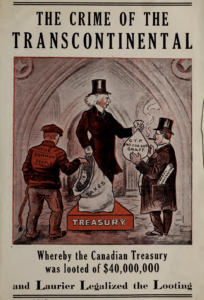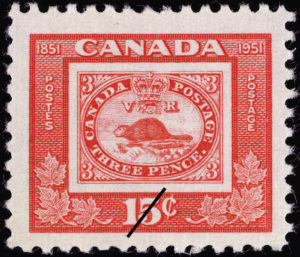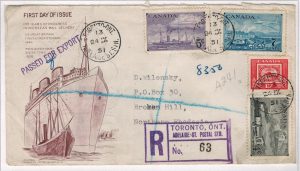On today’s date in 1913, the last spike was to complete the National Transcontinental Railway (NTR), which served as the Eastern Division of the Grand Trunk Pacific Railroad (GTPR), a 4,800-kilometre system built in the early 20th century.
Not to be confused with its parent company the Grand Trunk Railway, which was incorporated more than half a century earlier in 1852, the GTPR was incorporated in 1903 “as part of a plan put forth by the Grand Trunk Railway in response to proposals for a second transcontinental line following a route much to the north of the Canadian Pacific,” wrote Omer Lavallee and Raymond Corley in their August 1982 article, “The Grand Trunk Railway: A Look at the Principal Components,” published in the Railway & Locomotive Historical Society’s journal, the R&LHS Bulletin (now known as Railroad History).
This leg of the NTR ran from Prince Rupert, B.C., to Moncton, N.B., via Winnipeg, Sioux Lookout, Kapuskasing, Cochrane and Québec city. This final stage of the project began in 1903 and only the $40-million Québec Bridge – the largest cantilever span in the world – remained unfinished.
Canada then had three transcontinental railways, including the Canadian Pacific Railway; the Canadian Northern Railway from British Columbia to Nova Scotia; and the NTR/GTPR system.
In 1938, the newly formed Department of Transport reported the cost of construction exceeded the original estimates. Because the GTPR company was in financial difficulties, it was unable to implement the lease agreement.
The major cost overruns of the NTR/GTPR led to the downfall of Wilfrid Laurier’s federal Liberal party in 1911, when Conservative leader Robert Borden became prime minister.

The federal Conservative Party released a booklet, The Crime of the Transcontinental, in 1911 to highlight former prime minister Wilfrid Laurier’s perceived ‘looting’ of the country’s coffers.
A booklet published that year by the federal Conservative Party opposed what it deemed a generous handout given by Laurier for the NTR’s construction.
“We find that the Transcontinental Railway Commission, the Grand Trunk Pacific Railway and those having charge of the construction of the Railway, did not consider it desirable or necessary to practice or encourage economy in the construction of this road,” according to a report of the commission that investigated the NTR’s construction and was quoted in the Conservative Party booklet. “We find that, without including the money which was unnecessarily expended in building the railway east of the St. Lawrence River forty million dollars at least was needlessly expended in the building of this road.”
The Borden government then amalgamated the lines into the Canadian Government Railways, which along with the bankrupt Canadian Northern Railway merged into the Canadian National Railway in December 1918.

A 15-cent stamp issued as part of the 1951 set recreates the 1851 three-penny ‘Beaver,’ the first stamp issued in present-day Canada.
1951 TRAIN STAMPS
In 1951, Canada’s Post Office Department (known as Canada Post since 1981) released a four-cent stamp (Scott #311) showcasing the 100-year evolution of the country’s train technology.
The stamp’s lower design shows an old-fashioned wood-burning steam-engine train while the top-right corner features one of the first streamlined diesel-electric locomotives manufactured in Canada – at the Montreal Locomotive Works in April 1950 – for the Canadian National Railway between Montréal and the U.S. state of Vermont.
Designed by Herman Herbert Schwartz and engraved by Silas Robert Allen, the train issue was part of a four-stamp set (SC #311-14) released in 1951 to mark Britain’s transfer of postal responsibilities to British North America 100 years earlier. The three low denominations, including the four-cent stamp, highlighted various communications developments by land, water and air while the fourth issue (SC #314) recreated the 1851 three-penny “Beaver” (SC #1), the first stamp issued in present-day Canada.

A first-day cover mailed from Toronto to Rhodesia (present-day Zimbabwe) is franked with all four stamps issued in conjunction with CAPEX 51. Photo by Andrew Liptak, also known as ‘Philcovex’ on his Postal History Corner blog, now managed by the Postal History Society of Canada.
UNVEILED DURING CAPEX 51
The set’s first day of issue, Sept. 24, 1951, coincided with CAPEX 51, Canada’s first international philatelic exhibition, held in Toronto.
Also the first international philatelic exhibition held in the British Empire outside of England, CAPEX 51 was a “Who’s Who” of stamp collecting.
Vincent Greene served as the show’s chair, a role to which he returned for the CAPEX events in 1978 and 1987, the latter of which took place a year before his death. Among his many honours are the Roll of Distinguished Philatelists, which he signed in 1963, the Lichtenstein Medal, which he received a year later, and the American Philatelic Society (APS) Hall of Fame, to which he was posthumously inducted in 1989.
The first two CAPEX shows – 1951 and 1978 – were held at the Automotive Building (now Beanfield Centre) at Exhibition Place.
“This is the finest building we’ve ever seen for a stamp exhibition,” New York’s Ezra Cole and Edwin Müller are quoted as saying in a 1951 issue of the Canadian Philatelist.
Cole, a well-known dealer, was inducted to the APS Hall of Fame in 1993 while Müller was a European stamp expert known for his Austrian postmark catalogues. Both attended the inaugural nine-day show from Sept. 21-29.
In addition to 100-plus exhibits (with more than 50 coming from England alone), CAPEX 51 also featured eight conventions, including from:
- the American Airmail Society;
- American Philatelic Society;
- American Stamp Dealers Association;
- the British North American Philatelic Society;
- Canadian Philatelic Society;
- Confederate Stamp Alliance (now the Civil War Philatelic Society);
- and the Postal Historians of Great Britain; and
- the Postal Historical Society of Great Britain.
On Sept. 26, 1951, members of the Canadian Philatelic Society also mounted a plaque in the main entrance of the Canada Trust Building at 110 Yonge St. in Toronto (the site where Sir Sandford Fleming designed the 1851 three-pence “Beaver”). While the original building is long since demolished, with a new one put up in 1967, the plaque remains on a pillar just outside the bank’s east-facing entrance.
Canada’s fifth international show, CAPEX 22, is slated for next June 9-12 in Toronto. To learn more about next year’s CAPEX, CSN published a two-part series last May (in Vol. 45 #3) and June (in Vol. 45 #4).

